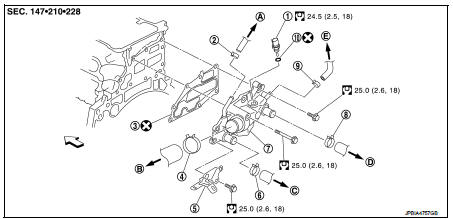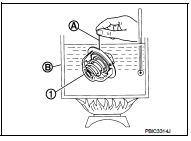Nissan Juke Service and Repair Manual : Water outlet
Exploded View

1. Engine coolant temperature sensor
2. Clamp
3. Gasket
4. Clamp
5. Bracket
6. Clamp
7. Water outlet
8. Clamp
9. Clamp
10. Washer
A. To electric throttle control actuator
B. To radiator
C. To CVT oil warmer
D. To heater core
E. To electric throttle control actuator
 : Engine front
: Engine front
 : Always replace after every
: Always replace after every
disassembly.
 : N·m (kg-m, ft-lb)
: N·m (kg-m, ft-lb)
Removal and Installation
REMOVAL
1. Drain engine coolant from radiator. Refer to CO-37, "Draining".
CAUTION:
• Perform this step when engine is cold.
2. Remove air duct (inlet) and air ducts. Refer to EM-161, "Removal and Installation".
3. Disconnect radiator hose (upper). Refer to CO-42, "Exploded View".
4. Disconnect harness connector from engine coolant temperature sensor.
5. Remove water hoses and heater hoses.
6. Remove water outlet.
7. Remove engine coolant temperature sensor from water outlet, if necessary.
INSTALLATION
Installation is the reverse order of removal.
Inspection
INSPECTION AFTER REMOVAL
Water Control Valve
• Place a thread (A) so that it is caught in the valves of water control valve (1). Immerse fully in a container (B) filled with water. Heat while stirring.
• The valve opening temperature is the temperature at which the valve opens and falls from the thread.
• Continue heating. Check the continuous valve lifting toward maximum valve lift.
NOTE
:
The maximum valve lift amount standard temperature for water
control valve is the reference value.
• After checking the maximum valve lift amount, lower the water temperature and check the valve closing temperature.
Standard: Refer to CO-54, "Water Control Valve".
• If out of the standard, replace water control valve.

INSPECTION AFTER INSTALLATION
• Check for leakage of engine coolant using the radiator cap tester adapter (commercial service tool) and the radiator cap tester (commercial service tool). Refer to CO-37, "Inspection".
• Start and warm up the engine. Check visually that there is no leakage of engine coolant.
 Thermostat
Thermostat
Exploded View
1. Radiator hose (upper)
2. Water inlet
3. Rubber ring
4. Thermostat
A. To radiator
: Always replace after every
disassembly.
: N·m (kg-m, ft-lb)
Removal and Installation
...
Other materials:
Description
NOTICE:
Trouble diagnoses indicate work procedures required to diagnose problems
effectively. Observe the following
instructions before diagnosing.
• Before performing trouble diagnoses, read the “Work Flow” in each section.
• After repairs, re-check that the problem has been completely elim ...
Cleaning
If your windshield is not clear after using the windshield washer or if a wiper
blade chatters when running, wax or other material may be on the blade or windshield.
Clean the outside of the windshield with a washer solution or a mild detergent.
Your windshield is clean if beads do not form whe ...
Floor mats
WARNING
To avoid potential pedal interference that may result in a collision or injury:
• NEVER place a floor mat on top of another floor mat in the driver front
position.
• Use only genuine NISSAN floor mats specifically designed for use in your vehicle
model. See your NISSAN dealer for more ...

